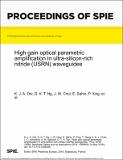| dc.contributor.author | Ooi, Kelvin J. A. | |
| dc.contributor.author | Ng, Doris K. T. | |
| dc.contributor.author | Choi, Ju Won | |
| dc.contributor.author | Sahin, Ezgi | |
| dc.contributor.author | Xing, Peng | |
| dc.contributor.author | Wang, Ting | |
| dc.contributor.author | Chee, Arthur | |
| dc.contributor.author | Kimerling, Lionel | |
| dc.contributor.author | Agarwal, Anuradha | |
| dc.contributor.author | Tan, Dawn T.H. | |
| dc.date.accessioned | 2021-11-09T17:53:13Z | |
| dc.date.available | 2021-11-09T17:53:13Z | |
| dc.date.issued | 2018-05 | |
| dc.identifier.uri | https://hdl.handle.net/1721.1/137999 | |
| dc.description.abstract | © 2018 SPIE. Optical parametric amplifiers rely on the high Kerr nonlinearities and low two-photon absorption (TPA) to achieve large optical amplification. The high Kerr nonlinearity enables efficient energy transfer from the optical pump to the signal. On the other hand, the TPA process competes with the amplification process, and thus should be eliminated. Through Miller's rule and Kramers-Kronig relations, it is known that the material's Kerr nonlinearity scales inversely proportional to the band-gap, while the TPA process occurs when the photon energy is larger than the band-gap energy and Urbach tails, thus presenting a trade-off scenario. Based on these requirements, we have designed a CMOScompatible, band-gap engineered nitride platform with ultra-rich silicon content. The silicon nitride material is compositionally engineered to have a band-gap energy of 2.1 eV, which is low enough to confer a high Kerr nonlinearity, but still well above the energy required for the TPA process to occur. The new material, which we called ultra-silicon-rich nitride (USRN), has a material composition of Si7N3, a high Kerr nonlinearity of 2.8x10-13 cm2/W, and a negligible TPA coefficient. In optical amplification experiments, 500 fs pulses at 14 W peak power and centered around 1560 nm are combined with continuous wave signals. The maximum parametric gain of the signal could reach 42.5 dB, which is one of the largest gains demonstrated on CMOS platforms to date. Moreover, cascaded four-wave mixing down to the third idler, which was usually observed for mid-infrared silicon waveguides, is unprecedentedly observed at this spectrum. | en_US |
| dc.language.iso | en | |
| dc.publisher | SPIE | en_US |
| dc.relation.isversionof | 10.1117/12.2306238 | en_US |
| dc.rights | Article is made available in accordance with the publisher's policy and may be subject to US copyright law. Please refer to the publisher's site for terms of use. | en_US |
| dc.source | SPIE | en_US |
| dc.title | High gain optical parametric amplification in ultra-silicon-rich nitride (USRN) waveguides | en_US |
| dc.type | Article | en_US |
| dc.identifier.citation | Ooi, Kelvin J. A., Ng, Doris K. T., Choi, Ju Won, Sahin, Ezgi, Xing, Peng et al. 2018. "High gain optical parametric amplification in ultra-silicon-rich nitride (USRN) waveguides." | |
| dc.contributor.department | Massachusetts Institute of Technology. Department of Materials Science and Engineering | en_US |
| dc.eprint.version | Final published version | en_US |
| dc.type.uri | http://purl.org/eprint/type/ConferencePaper | en_US |
| eprint.status | http://purl.org/eprint/status/NonPeerReviewed | en_US |
| dc.date.updated | 2019-09-20T18:14:27Z | |
| dspace.date.submission | 2019-09-20T18:14:29Z | |
| mit.metadata.status | Authority Work and Publication Information Needed | en_US |
